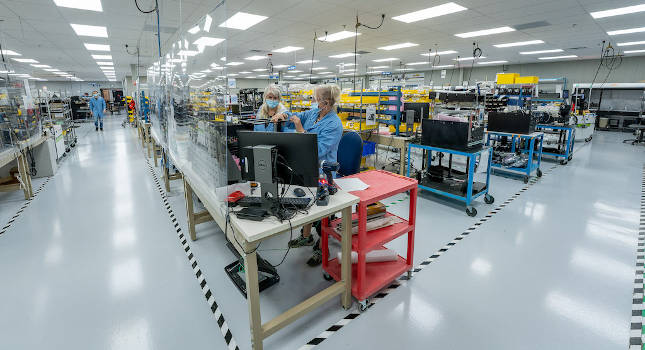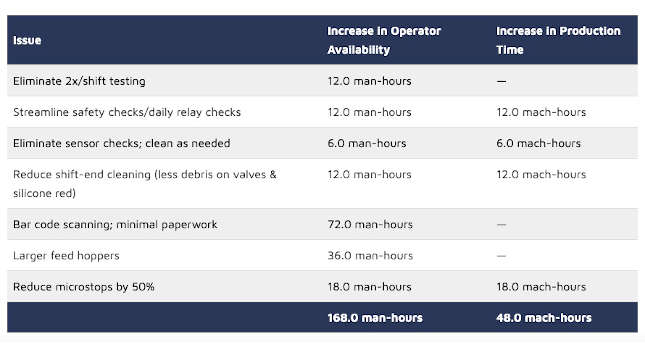Take a ‘CSI’ approach to root cause analysis to look beyond the obvious to determine why bearings are failing. Six types of failures and 12 tips for determining the root cause are featured.

A common phrase that is used throughout industry when a machine is experiencing unscheduled downtime is, “The bearing failed.” Even though the rotating component fails to turn, in most cases, it is more accurate to say that we failed the bearing. I’ve heard it said, by different reliability specialists, “Bearings don’t fail, they are murdered.” In my 40-plus years of selling, sizing, installing, observing and analyzing failed bearings, I have found this often to be the case. People find new and creative ways to kill their bearings every day.
With that in mind, for the sake of discussion, let’s ask the question, “Why do bearings wear out, lock up and go bang in the night?” In order to answer that question, we must understand that even though improvements in material science and bearing design geometry make for a potential theoretical design life of infinity, rotating components prematurely fail from a variety of causes.
The subject of bearing failure involves metallurgy, tribology and the operating environment, as well as the consideration of the applied loads. In some cases, a single event may have caused the failure. Other times, numerous complex incidents and conditions may have come together in a nexus of poor human decisions, harsh environmental settings, severe operational conditions and poor maintenance practices. All of these contribute to premature failure. Ultimately, this results in catastrophic failure of the rotating or reciprocating component and additional ancillary damage to associated mechanisms. Due to the high cost of lost production and the time constraints placed on maintenance departments, reality dictates that the problem-solving process be simplified and expedient.
The unverified quote attributed to Albert Einstein, “Everything should be kept as simple as possible, but no simpler” is a useful mindset when determining the root cause of a bearing failure. In order to correctly determine the reason why a bearing failed, a systematic way of problem solving needs to be employed by a reliability team. Root cause failure analysis (RCFA) is a problem-solving method used to determine the cause of an incident and separate it from the effects, as well as filter out the nonauditory noise, which can prevent the team from solving the problem and implementing the necessary corrective actions.
Avoiding assumptions and preconceptions during the process is sometimes difficult but absolutely necessary to define the nature of the problem. The team must dig deep, ask questions and approach the challenge with a CSI mentality, and of course, determine, implement and follow up on the corrective action and countermeasures.
Look beyond the obvious
At first glance, a bearing failure may appear to be caused by not enough grease. But this answer is a too simplistic and a convenient excuse. The actual root causes of the bearing failure may be that it lacked the correct lubricant viscosity, proper delivery method, or intervals for the application.
The obvious effects may be heat, smoke, auditory noise and unscheduled downtime. The analytical noise in the problem-solving process is extraneous and will hinder the determination of the root cause and implementation of corrective measures. Nonauditory noise is actually an ancillary effect. Examples are: complaining, bad tribal knowledge and distractive thinking. If the problem-solving team stays focused and continues to dig deep, the root cause may actually be a lack of lubrication training and a laissez-faire culture towards tribology.
For the sake of simplification, let’s group bearing failures into six major categories. They are: fatigue, handling/installation, operational, environmental, lubrication and defect. Even though there are a myriad of often times confusing terms used to describe bearing failures and the visual effects observable on the bearing, these six types of failures will be used to categorize the typical failures occurring in industry. Categorization is not absolute, but used for the sake of problem solving.
1. Fatigue
Stress over time, which is fatigue failure, is the right reason why bearings should eventually stop rotating. This cause of failure is different than wear. Fatigue failure is related to the stress the bearing is subjected to over time. Fatigue failures in bearings typically originate sub-surface and eventually will propagate to the surface, and in time, will appear in what is referred to as a spall (see Figure 1).
Fatigue failure is, in part, interrelated to the purity and the quality of the steel. With advances in steelmaking over the last few decades, micro-inclusion impurities within the bearing steel are minimal. Calculating the fatigue life of a bearing takes into consideration, load, speed and cycles or time. Bearing engineers use the L10 life of a bearing, along with dimensional restrictions and the bearing’s design, for selecting a bearing. L10 life is a life calculation where 90% of identical bearings are handled, installed, lubricated and run under the same operating and environmental conditions, without metal fatigue. This is the ideal reason for the cause of failure.
2. Handling/Installation
Improper handling and installation practices often kill the bearing before it has been installed or rotated. Storage in a wet or highly contaminated environment is detrimental to the bearing’s life. Bearings should be stored, flat, dry, clean and in good order. The temperature should not vary widely from summer to winter. Humid environments are not conducive to extended bearing life. Access should be controlled to prevent unnecessary opening and movement.
If bearings are stored, or a machine is idle for an extended time, the lubricant within the bearing may leach out and puddle at roller intervals-causing an acid etching of the surfaces.
If the fit between the shaft and inner ring, or the housing and outer ring, is not within the recommended specifications for the application, fretting-corrosion on the surfaces will be evident. This is a different type of corrosion than that caused by invasive water and oxygen. Fretting-corrosion occurs when there is movement between a bearing ring and shaft or housing because the fit is too loose. Microscopic steel particles break off due to movement and oxidize.
This will result in the appearance of areas of corrosion on the surfaces of the rings. In extreme cases of inadequate fit, the outer or inner ring may turn or creep, resulting in galling of the surfaces. The remedy for this is to measure all mating components prior to installation and make sure they are within the fit recommendations. If not, it’s time for a new shaft or housing.
Ambient vibration during storage should be minimized, and bearings should never be stored upright on a shelf. False brinelling of the metal surfaces is caused when the roller and ring are in contact with each other and subjected to vibration over time, resulting in the wearing away of the metal.
If the bearing is dropped while it is being handled, a form of mechanical damage referred to as a true brinelling will result. This material displacement or dent, where the rollers and races contact each other, may also be caused by force fitting the bearing (see Figure 3), or through the use of an improper mounting tool, such as a hammer.
Striking a steel bearing directly with a hammer is dangerous and could result in the bearing exploding. The human condition that all too often leans towards carelessness and urgency is a big part of this failure equation.
I recall a time when I was passing through a customer’s facility and noticed a man on a forklift truck delivering a new motor for installation. When the driver turned the corner, at too high of a speed, the motor rolled off the pallet and hit the floor, shaft first. That bearing was murdered before it had a chance to operate.
3. Operational issues
This category includes negative operating conditions other than those related to the environment. Excessive thrust loads, misalignment, extreme vibration or the passage of stray current through the bearing, known as electrical erosion, are a few of the major faults seen while the bearing is in operation. Many of these types of failures are evident when examining the ball or roller path on the raceway surface, especially in the load zone of the rings.
If the bearing is misaligned beyond its capacity, the path of the rollers will appear to skew from one side to the other. Proper alignment is critical to extending the operating life of rotating components.
Extreme thrust will be evident by observing an off-center roller path. In ball bearings, a disproportionate thrust load will result in the roller path being offset in the raceway groove and not in the bottom of the arc. Taper roller bearings subjected to misalignment will cause edge-loading and localized spalling at the ends of the rollers and the mating portion of the raceway.
Excessive vibration in the operating machine due to out-of-round rotating components will cause the bearing rollers or balls to bounce and skid as they come in and out of the load zone. This wavy or wash-board pattern is referred to as false-brinelling. Keep in mind that static false-brinelling may occur while the bearing is idle (see Figure 4). A dynamic false-brinelling pattern is usually more extreme than that which occurs while the bearing is static.
With the increased use of variable frequency drives, bearing failures attributed to electrical erosion have become more common. Electrical erosion occurs when there are improper grounding or rotor issues that allow for the passage of current from the race to the rolling elements, creating arc pits in the steel. The first stage is micro-pits, some of which cannot be seen by the human eye. These soon turn into a pattern referred to as fluting (see Figure 5). It usually can be prevented by shunt brushes retrofitted onto the motor or by installing ceramic-ball or ceramic-coated outer rings.
4. Environmental issues
Environmental conditions have a dramatic influence on the life of the bearing. Contamination inhibits proper lubricant film. Every reasonable attempt should be made to keep the bearing dry, cool and clean. In many cases this is difficult to do, as in a foundry filled with heat and sand, or in a food plant where the machines are subjected to nightly washings by a high-pressure hose. Exposure to moisture, chemicals, fine dust, large particle dirt and extreme heat will result in a shortened life. A little guarding and quality sealing goes a long way to enhance the serviceable life of the bearing.
Particulate contamination interrupts the all-important lubricant film and causes metal-to-metal contact, which results in wear and momentary welding of the rotating component to the race surface. Foreign particles along with bearing steel particles may dent and score the contact surfaces of the bearing (see Figure 6). Small particles trapped and suspended within the lubricant will act as a lapping compound and wear away the surfaces of the steel and retainer materials, causing abrasive wear. Larger particles dent the surfaces, resulting in fragment denting. This type of contamination is usually easily spotted by the presence of the particles, discoloration of the lubricant, or through lubricant analysis.
Bearings that have become contaminated with water will rust and corrode. Even 1% by volume or less than 500 ppm contamination of the lubricant will cut the life of the bearing significantly.
It’s not just the corrosion that kills the bearing; the water replaces the necessary lubricant film and also degrades the lubricant by oxidizing it and creating acids. Along with that, in some extreme conditions, hydrogen embrittlement or blistering may occur.
Contaminant exclusion devices and strategies are always a good investment. Water and dirt are a menace and the enemy of rolling element bearings.
5. Lubrication
Lubrication issues are one of the primary causes of bearing failures. Bearing lubrication should be put at the top of the list of maintenance concerns. The proper storage, handling and dispensing, along with education and analysis, need to be a part of the maintenance department’s lubrication reliability goals. The correct type, amount, lubrication frequency intervals, application method, viscosity and cleanliness of the oil or grease, along with the issue of compatibility, will all have a dramatic effect on the service life of the bearing.
Bearing raceways that receive inadequate lubrication will have a glazed or frosty appearance. This glazing is a result of metal being pulled from the surface after momentarily welding together. This “picking,” as it is referred to, leaves a rough finish on the mating surfaces. If the lubricant film is inadequate as the rolling element enters the load zone, it will skid or slide creating a smear (see Figure 7). A lubricant that is too stiff, too viscous or spare will cause smearing on the race surfaces in the load zone.
In extreme cases of inadequate lubrication, the temperature will continue to rise, resulting in further lubricant degradation and metallurgical changes evident by discoloration of the rings. Grease that has a burning smell or has a charred appearance is degraded. Oil that has a milky appearance is full of moisture.
A significant issue pertaining to modern lubricants is compatibility. With complex formulas and additives, mixing of lubricant types and brands is a recipe for failure.
A lubrication program must be implemented that is led by a technician who is trained, certified and passionate about lubrication. The program should involve color-coding, proper storage and handling, along with cleanliness.
6. Defects
Today, defective bearings are virtually nonexistent, thanks to current precision work practices, quality steel and redundant dimensional tolerance checks as part of the manufacturing process.
This holds true for all reputable manufacturers. Beware of discounted, grey market or counterfeit products. Only a few times have I seen defectively manufactured bearings, almost all of which were from questionable companies.
Properly conducted post mortem failure investigations or retrospective analysis of bearings can save you time, money and lost production. Avoiding premature failure is the goal, which will lead to plant reliability.
Remember, bearings usually don’t fail us. We fail them.
The root cause of bearing failure: 12 things to look for in the analysis
How do we determine the root cause of a bearing failure and prevent it from happening again? Here are 12 keys to that analysis:
-
Save the failed parts and mark them (date, time, direction, location, etc.).
-
Order the analysis. Use a problem-solving system such as 5-Whys for RCFA.
-
Use a multi-faceted approach to condition monitoring by incorporating, vibration analysis, thermography, lubricant sampling and ultrasound data collection.
-
Take pictures and document.
-
Analyze the collected data. Watch for trends.
-
Separate and differentiate cause, effect and nonauditory noise. Determine the root cause of failure.
-
Use a team of employees and industry specialists and implement the team’s recommendations.
-
Avoid blaming individuals.
-
Change the culture away from run to failure.
-
Hold regular training sessions; education is important.
-
Follow up.
-
Expand on and communicate the successful solution to others.
Richard R. Knotek is a technical training specialist with the Motion Institute, a division of Motion Industries, and has 42 years of industry experience. For more information, visit www.motionindustries.com or its video channel MiHow2.com.



